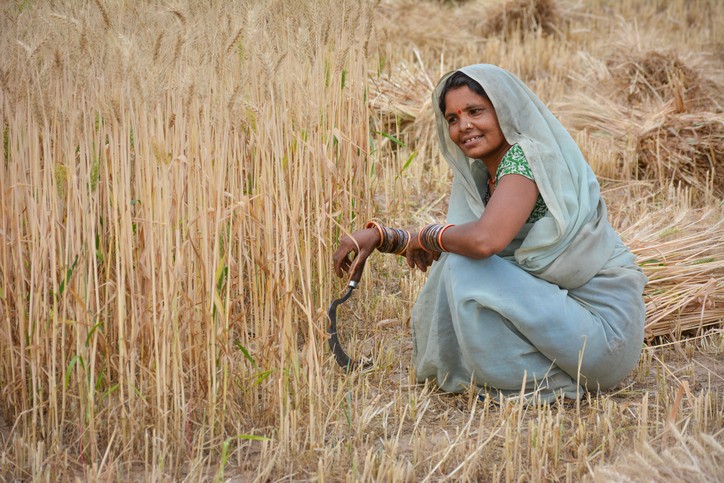Problems of Women Farmers
September 17, 2023
Introduction
Agriculture sector employs 80% of all economically active women in India; they comprise 33% of the agriculture labour force and 48% of the self-employed farmers. Economic Survey 2017-18 says that with growing rural to urban migration by men, there is ‘feminisation’ of agriculture sector, with increasing number of women in multiple roles as cultivators, entrepreneurs, and labourers.
Problems of Women Farmers in India:
- Limited Land Ownership and Control: In many parts of India, women have limited access to land and property ownership due to patriarchal land tenure systems. According to Oxfam (2013), around 80 per cent of farm work is undertaken by women in India. However, they own only 13 per cent of the land. Recent statistics released by the University of Maryland and the National Council of Applied Economic Research (NCAER, 2018) state that women constitute over 42 per cent of the agricultural labour force in India, but own less than two per cent of farmland. According to the India Human Development Survey (IHDS, 2018), 83 per cent of agricultural land in the country is inherited by male members of the family and less than two per cent by their female counterparts.
| Recently, a survey conducted by the Mahila Kisan Adhikar Manch (MAKAAM, 2018) of 505 women farmers (whose husbands committed suicide due to farm crisis) in 11 districts across Marathwada and Vidarbha, found that 40 per cent of women widowed by farmer suicides between 2012 and 2018, were yet to obtain rights of the farmland they cultivated. Among them, only 35 per cent had secured the rights to their family house. The survey also found that 33 per cent women didn’t know they were entitled to a pension, which makes it evident how women have been excluded from accessing institutional rights and entitlements, in the absence of them being recognised as farmers. |
- Unequal Access to Resources: Studies have shown that women have less access to inputs (seeds, fertiliser, labour, and finance), critical services (training, insurance) and organised markets when compared to their male counterparts. For example, Mobile phones are becoming a very important tool in farming- to buy, sell, report, debate, transfer money, claim insurance. However, in countries like India women are 10% less likely to own a mobile phone than men, and 313 million fewer women than men use mobile internet. This inequality can lead to lower productivity and limited economic opportunities.
- Unpaid and Underpaid Labor: Women’s agricultural work, both in the fields and at home, is often unpaid or undervalued. According to a study by the OECD, women in India spend an average of 6 hours a day on unpaid work, compared to 52 minutes a day for men. This unpaid labour is not counted in economic statistics, leading to a skewed perception of their contributions to agriculture.
- Lack of Education and Training: An estimated 52-75%of Indian women engaged in agriculture are illiterate, which is a significant education barrier that prevents women from access to agricultural information. This lack of education and access to information limits their ability to invest in modern farming techniques, equipment, and inputs that can improve their yields and quality. It also limits their ability to obtain institutional loans from banks that usually consider land as collateral
- Gender Norms and Discrimination: Deeply entrenched gender norms and discrimination in rural communities can restrict women’s mobility, decision-making authority, and participation in agricultural activities. Additionally, reluctance of women to avoid any conflict with male members of the family and relatives are other factors that inhibit accessibility to agricultural land to women.
Thus, according to Bina Aggarwal (1993), a number of factors constrain women in exercising their legal rights including patrilocal post-marital residence, village exogamy, opposition to mobility from men, traditionally institutionalised gender roles, low female literacy and awareness, male dominance in administrative, judicial, and other public decision-making bodies at all levels. Aggravating the issues further is the improper maintenance of land records, poor management of data, and limited digitisation of land records, which affect implementation of agricultural schemes meant to uplift farmers in general, as such challenges make identification of beneficiaries difficult.
Proposals for Benefit of Women Farmers
- The recent thrust by the government on aggregation through Farmer Producer Organisations (FPOs) is an impactful mechanism for addressing some of these fundamental challenges of lack of agency, price inequalities and women’s participation in production and market systems.
| In Bihar, the JEEViKA programme – has mobilised over 200,000 women small-farmers into commodity-based FPOs. These FPOs have achieved significantly higher turnover and successfully marketed grains, fruits and vegetables. Farmer level returns, in some cases, have gone up by 20-30%. |
- In 2011, M S Swaminathan, Rajya Sabha member (2007-13) proposed the ‘Women Farmers Entitlement Bill’, which lapsed in 2013. With increasing recognition being given to the contribution of women in agriculture such as by commemorating the ‘Rashtriya Mahila Kisan Divas’, it is time that such legislations and institutional reform in agriculture are addressed.
- The National Bank for Agriculture and Rural Development (NABARD) has launched a microfinance initiative that provides credit without collateral to women farmers. This can help them access credit more easily and invest in their farms
- The government can provide better access to technology and other resources through various schemes such as the Mahila Kisan Sashaktikaran Pariyojana (MKSP) that aims to empower women farmers through capacity building, training, and market linkages
Conclusion
According to the Food and Agricultural Organization (FAO, 2011), empowering women through land and ownership rights has the potential of raising total agricultural output in developing countries by 2.5 to 4 per cent and can reduce hunger across the world by 12-17 per cent.
The Sustainable Development Goal (SDG #5. a.1), seeks to grant property rights and tenure security of agricultural land to women. Policy paralysis in granting entitlements to women in agriculture and farm widows needs to be addressed to empower rural women economically, politically, socially, and psychologically.
The most critical issue that needs to be addressed toward a gendered friendly policy is to minimize the gulf between ownership versus control of land by addressing patriarchal conventions and bottlenecks in interpersonal legislations, to achieve economic equality in gender, as also guaranteed by the Indian Constitution, under the aegis of Article 14.



